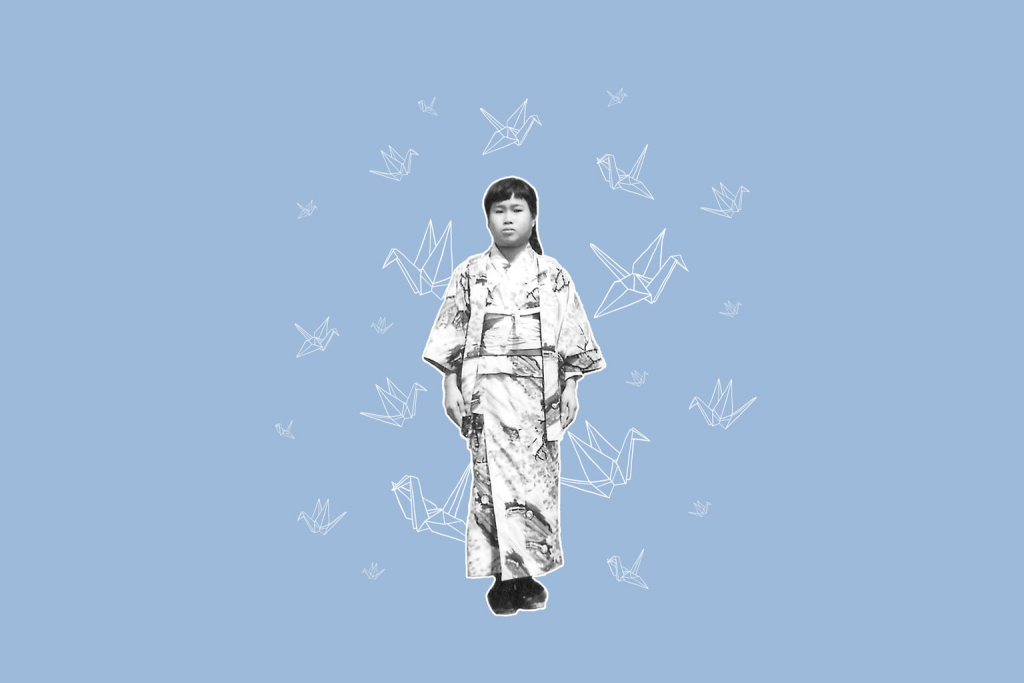On this day 76 years ago Sadako Sasaki was blown out of her house window by the atomic bomb dropped on Hiroshima. Though feared dead, she remarkably survived without any visual injuries. Tragically, as she and her mother escaped, they were caught in black rain.
10 years later, Sasaki was diagnosed with acute malignant lymph gland leukemia (referred to as atomic bomb disease” in Hiroshima). She died on October 25, 1955, aged just 12. Her memory, though, lives on thanks to the more than 1,000 paper cranes she folded while ill in the hospital.
Background
Sasaki was born on January 7, 1943, to parents who ran a barbershop. Her father was drafted into the army soon after her birth, so she lived with her grandmother, mother and brother. The family home was around 1.6km from Shima Hospital, which is considered ground zero of the bombing of Hiroshima. The 13-kiloton uranium atomic bomb, known as Little Boy, destroyed much of the city and instantly killed up to 80,000 people. The true mortality rate will never be known, though estimates range from 90,000 to 146,000 in the four months after the attack.
Sasaki was just two years old when the aircraft Enola Gay dropped the weapon. Blasted out of the house, her mother despairingly went to look for her. Amazingly, when she found her, there were no noticeable scars. With fires breaking out all over the place and radioactive black rain falling from the sky, the Sasakis attempted to escape. Her grandmother, however, didn’t make it. According to Sasaki’s brother, she died putting her head into a cistern to avoid the fires.
The family home and barber shop burned down. However, with their father returning home, the family eventually started to rebuild their lives as well as their business. Sasaki entered Nobori-cho Elementary School where she soon garnered a reputation as a fast runner. Enjoying her time in and out of the classroom, she dreamed of one day becoming a P.E. teacher. Regarding her health, there didn’t seem to be anything too unsettling in her early years as a pupil. Then, towards the end of 1954, she started to develop lumps on her neck and behind her ears followed by purpura (purple spots) on her left leg.
1,000 Origami Cranes
In early 1955, Sasaki was diagnosed with leukemia, hospitalized and given less than a year to live. Her family didn’t want her to lose heart so didn’t reveal to her the gravity of the situation. When classmates came to the hospital to visit, Sasaki would ask them about junior high school. They would answer as positively as they could, though knew she would never be joining them at the school. The young patient remained upbeat despite the painful blood transfusions.
After witnessing the death of a five-year-old girl in her ward named Yuki, who had similar spots on her leg, Sasaki realized she could be next. Though disheartened, she remained hopeful. In August, a school in Nagoya sent the hospital where she was staying a gift of 1,000 multi-colored paper cranes with the intention of giving the patients encouragement. According to ancient Japanese legend, anyone who folds 1,000 origami paper cranes will be granted a wish by the gods. This gave the youngster an idea. She decided to begin folding her own paper cranes while praying for recovery from illness.
At the time paper wasn’t easy to get hold of so Sasaki would try to find whatever she could including medicine paper wrappings. Determined to reach the 1,000-mark as soon as possible, her father was worried that she was pushing herself too hard. “If you keep up that pace, you’ll wear yourself out,” he told her. By the end of August, she’d completed her goal, but didn’t want to stop there. According to her family, she folded more than 1,300 before her death. On October 25, 1955, Sasaki uttered her last words. “It’s good,” she said after eating tea on rice before thanking her parents. The brave girl took one more spoonful before she passed away.
Sasaki’s Legacy
Following Sasaki’s death, students from Nobori-cho wanted to do something to honor their former classmate as well as other children who died as a result of the atomic bomb. That included Yoko Moriwaki, who became known as the “Anne Frank of Japan” due to her wartime diary. The idea was to erect a monument in Hiroshima. A meeting for junior high school principals took place in the city and the pupils used this occasion to distribute handmade flyers. It had the desired effect. Donations poured in from prefectures throughout the country.
The monument, designed by artists Kazuo Kikuchi and Kiyoshi Ikebe, was unveiled on May 5, 1948 (Children’s Day). At the top, Sadako has been immortalized with a wire crane above her head. People from around the world leave paper cranes at the site. There’s also a peace bell and a bronze crane that acts as a wind chime. Both were donated by Nobel laureate Hideki Yukawa. At the base of the monument, the message is simple but powerful. “This is our cry, this is our prayer: For bringing peace in the world.”
In 1977, Canadian American author Eleanor Coerr published Sadako and the Thousand Paper Cranes. In the tale, the young girl only completes 644 cranes before her friends take over to finish the task. Wanting to give a true account of her life, Sasaki’s brother Masahiro worked with Sue DiCicco on The Complete Story of Sadako Sasaki. “I cannot help feeling that Sadako was born with a special mission,” he said on a DW News documentary. “Every time I see the monument, I feel that Sadako taught us deep compassion which can lead to peace. This is what Sadako left to us. I feel that way and I feel proud of her.”
*Feature image by Anna Petek









